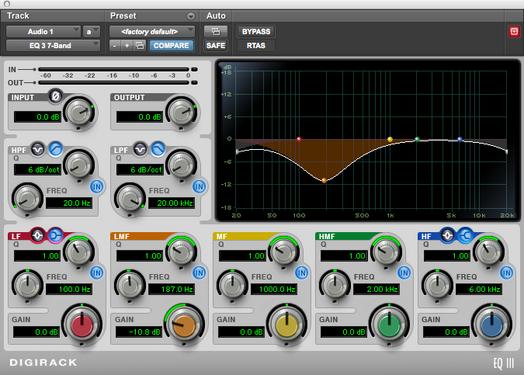I've been wondering this awhile now. On the generic Pro Tools graphic equalizer, the frequencies are unequally spaced. For example, there is a large gap between 100hz and 200hz. But between 200hz and 300hz, the gap is about half as wide. Can someone explain the reasoning for this?
Comments
Most graphic equalizers are offered in octave widths which would
Most graphic equalizers are offered in octave widths which would be five bands. Half octave, 10 bands. Third octave, 31 bands.
And this is also why folks came up with console mounted parametric equalizers. This is where you can sweep the frequency to any frequency and also vary its Q a.k.a. bandwidth. Simply because you wouldn't necessarily want to raise frequency bands centered upon frequencies you don't need to augment reduce or cut. So the equalizer that you choose usually has more to do with the application in which you need to equalize and how, where and by how much. But when you find a graphic equalizer within a console, they are usually half octave equalizers having approximately 9 frequencies in which can be controlled that do not overlap with each other. Octave equalizers give you more of that " British sound " because of their wider Q, affecting a broader range of frequencies with a single control. Many software equalizers give you selections for octave, half octave and third octave graphic equalizers. At least Adobe Audition does which is actually my software of choice. I rarely use my ProTools for much of anything. I only got that for other clients that requested it.
Graphic EQ's are quick and fast to use. No stupid tuning of frequency selections. Just grab and go.
Mx. Remy Ann David
EVHalen, post: 392112 wrote: This is what I'm talking about. For
EVHalen, post: 392112 wrote: This is what I'm talking about. For example, it appears that it would be much harder to boost or reduce 926hz, than it would for 126hz. Why didn't the designers just space it all evenly?
That's not exactly a graphic eq, it's a parametric eq with a graphic display of the frequency response.
I don't get the problem. You can adjust the filter frequency centers and widths to whatever suits your needs. If you want to boost or cut 926Hz just pick a filter (probably the MF) and set the frequency control to 926.
I guess "harder to boost or reduce 926hz, than it would for 126h
I guess "harder to boost or reduce 926hz, than it would for 126hz" sounded like a description of a problem.
The filters overlap but do not cover the whole audio spectrum. They probably default at or near the centers of their ranges, and their ranges are probably determined by Digidesign's/Avid's assumptions about what people use most. They are just defaults, about as meaningful as what station your car's radio was set to when you first drove it.





Hi, and Welcome to Recording.Org. If I understand your question
Hi, and Welcome to Recording.Org.
If I understand your question (and I'm not 100% sure I do) - you're wondering why there aren't the same number of bands available between 100 - 200, as there are between 200 - 300. If I've missed the point of your question I apologize and will answer the question I just made up. In which case, you'll have to have another go at asking your question...
The typical center-frequencies of a 31-band graphic EQ each represent 1/3 of a musical octave. And when a frequency is doubled, it is an octave higher. In other words, each group of three adjacent sliders controls one of the ten octaves in the spectrum of sounds humans can hear.
So for example on the EQ I'm looking at now, the lowest band is 25Hz. And as I said, when you multiply the number x 2, it's an octave higher. So, an octave above that is 50Hz (three sliders to the right). An octave above that is 100 Hz (three sliders to the right) - and so on at 200Hz, 400Hz, 800Hz, 1600Hz, 3200Hz (usually deviated to 3150Hz), 6300Hz, 12500Hz.
So to answer your question (as I understand it) - the bands between 100Hz - 200Hz (inclusive) represent a full octave of the audio spectrum. Where the range between 200Hz and 300Hz does not. You would have to include 400Hz to get to the full octave.
I hope that answers the question you asked, and makes sense.